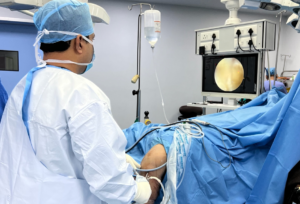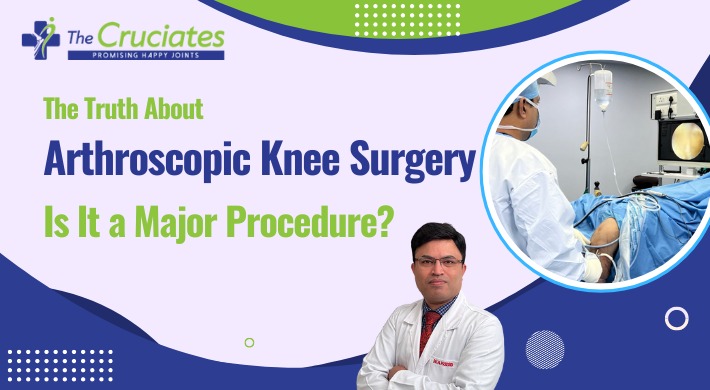Arthroscopic knee surgery is a minimally invasive procedure that is often used to treat a variety of conditions related to the knee joint. While this type of surgery has become increasingly popular, many people are still unsure of whether it is a major procedure or not. In this blog post, we will explore the truth about arthroscopic knee surgery, including its indications, how it is performed, how successful it is, and where to find the best knee, arthroscopic surgeon.
What is arthroscopic knee surgery?
Arthroscopic knee surgery is a minimally invasive surgical procedure that uses a tiny camera to look inside your knee. It can help diagnose and treat various knee problems, including ACL tears, meniscus tears, and PCL tears. During the procedure, the surgeon will insert a small tube with a camera attached into the knee joint. This allows them to see the inside of the knee and identify any issues or damage. The surgeon can then use specialized instruments to repair or remove damaged tissue, if necessary. The goal of arthroscopic knee surgery is to improve the patient’s range of motion and reduce pain.

Indications of knee arthroscopy
Arthroscopic knee surgery is a minimally invasive procedure that is used to diagnose and treat various knee conditions. Some of the most common indications for arthroscopic knee surgery include an ACL tear, PCL tear, meniscus tear, synovitis, osteochondral pathology, and the removal of loose bodies.
An ACL tear can be caused by sudden twisting of the knee or a direct impact on the knee. Symptoms of an ACL tear include instability in the knee joint, pain, swelling, and difficulty walking. ACL surgery is often recommended to repair the damage and stabilize the knee joint.
A PCL tear can occur after a direct blow to the front of the knee, or when the knee is hyperextended. Symptoms include swelling, pain, instability in the joint, and difficulty standing or walking on the affected leg. A PCL surgery may be required to repair the injury and restore stability in the joint.
A meniscus tear is an injury to one of the two c-shaped structures that cushion and protect the knee joint. Symptoms include pain, swelling, and difficulty fully extending or flexing the knee. Meniscus surgery may be recommended if conservative treatment is not successful in relieving the symptoms.
Synovitis is inflammation of the lining of the knee joint which causes pain, swelling, stiffness, and warmth around the affected joint. Arthroscopic surgery may be recommended to remove inflamed tissue and restore movement in the joint.
Osteochondral pathology is an injury to the bone or cartilage in the knee joint. Symptoms include pain, swelling, stiffness, and difficulty bearing weight on the affected leg. Arthroscopic surgery may be used to remove damaged tissue and relieve pain.
Loose bodies are pieces of cartilage or bone that have become detached from the knee joint and are floating freely within it. Symptoms include pain, swelling, and stiffness in the joint. Arthroscopic surgery can be used to remove loose bodies and restore normal movement in the joint.
How is knee arthroscopy performed?
The patient is usually positioned lying flat on their back with their knee Flexed. Local or regional anaesthesia is used, with spinal anaesthesia being preferred. This type of anaesthesia helps numb the area and allows the patient to remain awake during the procedure. After numbing the skin, the surgeon will make two or three small cuts around the knee, insert the arthroscope, and use special instruments to repair any damage. The entire procedure takes about one hour and patients are usually able to return home the same day.
How successful is arthroscopic knee surgery?
When it comes to arthroscopic knee surgery, the success rate is quite high. Generally speaking, patients can expect excellent results with procedures such as ACL surgery, meniscus surgery, and PCL surgery. Studies have shown that a majority of patients who undergo arthroscopic knee surgery experience significant improvement in their pain and mobility. Furthermore, research indicates that a majority of patients return to their pre-injury level of activity following arthroscopic knee surgery.
The success rate of arthroscopic knee surgery is highly dependent on the skill of the surgeon performing the procedure. Therefore, it is important to find a skilled, experienced surgeon who specializes in arthroscopy. Additionally, patient compliance with pre-operative and post-operative instructions is critical to achieving the best outcome after arthroscopic knee surgery.
Overall, arthroscopic knee surgery can be a safe and effective treatment for many orthopaedic conditions. When performed by an experienced and competent surgeon, this procedure offers a high success rate in terms of pain relief, increased mobility, and improved quality of life.
Where to find the best knee, arthroscopic surgeon
“The Cruciates” is a team of highly experienced and skilled surgeons who are in the sports medicine field for a long time and have dealt with complicated sports injuries. Dr. Nagendra Prasad one of the best arthroscopy surgeons in India leads the team. The Cruciates is committed to delivering high-quality services and would like to make sure that, you are satisfied with our work. The team Cruciates provides customized treatment and follow-up to each patient to make sure that everyone will achieve the desired level of recovery and rehabilitation to ensure an early return to sports.

